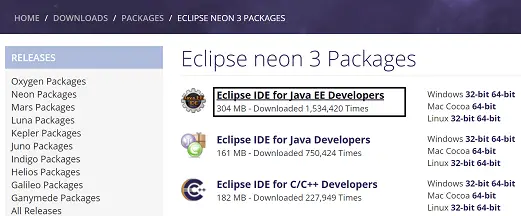Cucumber JVM Eclipse Plugin was created by James Phillpotts a year ago. It is hosted on GitHub. For newer version check Cucumber-Eclipse Llisted in Nodeclipse Plugins List. For example, if you are using Eclipse Kepler, choose Oracle Enterprise Pack for Eclipse Kepler. On the next page, the features that will be installed are listed.


Install Java before installing Eclipse.
You may want to print these instructions before proceeding, so that you can refer to them while downloading and installing Eclipse. Or, just keep this document in your browser. You should read each step completely before performing the action that it describes. This document shows downloading and installing Eclipse on Windows 7 in Spring 2012..
Eclipse: Version 4.3 (Kepler)
Eclipse Software Download
The Eclipse download requires about 182 MB of disk space; keep it on your machine, in case you need to re-install Eclipse. When installed, Eclipse requires about an additional 220 MB of disk space.
Downloading
- Click Eclipse.
You following page will appear in your browser. In this handout we will download Eclipse Classic 4.3 for Windows 32 Bit; if your computer uses Windows, continue below; otherwise look above the column of 'green arrows' for the label Eclipse Kepler (4.3) Packages for and in the pull-down list to its right, choose either Mac OS X (Cocoa) or Linux and then continue below.
- Click the 32 Bit Operating System for your machine (even if you know your Operating System is 64 Bits and even if you downloaded the 64 Bit version of Python), under the heading Eclipse Classic 4.3 (182 MB) (the second icon from the top).
You will see the following page (don't worry about the name of the institution to the right of the big downward pointing arrow).
- Click the big downward pointing arrow underneath the Download eclipse-SDK-4.3-win32.zip from: The site named here, in purple to the right of the arrow: [United States] Georgia Tech Software Library (http) is the random one chosen by the download page this time.
This file should start downloading in your standard download folder. This file is about 182 Mb so it might take a while to download fully if you are on a slow internet connection (it took me about 3 minutes over a cable modem). Don't worry about the exact time as long as the download continues to make steady progress.
The file should appear as
Terminate the window browsing the Eclipse download.
- Move this file to a more permanent location, so that you can install Eclipse (and reinstall it later, if necessary).
- Start the Installing instructions directly below.

Installing (for Java)
Eclipse Kepler Download For Mac Free
Eclipse Kepler Download 64 Bit

- Unzip eclipse-SDK-4.3-win32.zip, the file that you just downloaded and moved.
On my machine (running Windows 7), I can- Right-click the file.
- Hover over the IZArc command from the menu of options.
- Click Extract Here
If you do not have IZArc or an equivalent unzipping program, here is the web site to download a free copy of IZarc.
Unzipping this file creates a folder named eclipse. You can leave this folder here or move it elsewhere on your hard disk. I recommend putting the downloaded file and resulting folder in the C:Program Files directory.
- Create a shortcut on your desktop to the eclipse.exe file in this eclipse folder:
On most Windows machines, you can- Right-press the file eclipse.exe
- Drag it to the desktop.
- Release the right button.
- Click Create shortcut here
Now you are ready to perform a one-time only setup of Eclipse on your machine.
- Double-click the shortcut to Eclipse that you just created above.
The following splash screen will appear
and then a Workspace Launcher pop-up window will appear.
In the Workspace text box, your login name should appear between C:Users and workspace, instead of Administrator.
Leave unchecked the Use this as the default and do not ask again box. Although you will use this same workspace for the entire quarter (checking projects in and out of it), it is best to see this Workspace Launcher pop-up window each time you start Eclipse, to remind you where your workspace is located.
- Click OK.
Progress bars will appear as Eclipse loads.
Eventually the Eclipse workbench will appear with a Welcome tab covering it.
- Terminate (click X on) the Welcome tab.
You will not see the Welcome tab when you start Eclipse after this first time.
- Locate the workspace folder created in step 3 (see C:Usersyournameworkspace).
Download (right-click and Save link as) IntroLib: Course Library Jar... into the same folder that you are using as your workspace (or move this file into the workspace folder after downloading it elsewhere).
- Click Window (to the left of Help on the far right of the line below this window's blue title Java - Eclipse SDK) and then click Preferences in its pull-down menu, as shown below.
- Disclose Java by clicking the + in front of Java or double-clicking Java (after the +); the + changes to a -.
Disclose Installed JREs similarly.
The Preferences pop-up window should appear as follows (although the path under Location might be different on your machine). - Under the Name column, double-click the icon.
The Edit JRE pop-up window will appear.
- Click Add External Jars....
- In the Jar Selection window, navigate to your workspace folder, and double-click the file introlib.jar.
- Scroll down the JRE system libraries pane and observe the introlib.jar file now at the bottom.
- In the Edit JRE window, click Finish.
- In the Installed JREs window, click OK.
- Terminate (click X on) the Eclipse window.
Comments are closed.